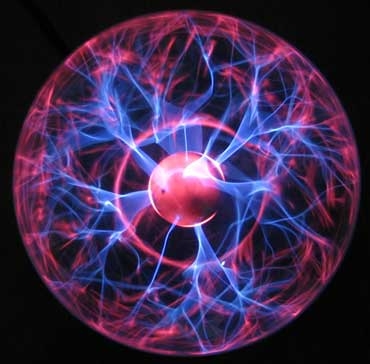
Putting the “Science” in “Science Fiction”: Plasma
Much like lasers, plasma weapons are a staple of modern science fiction that rarely have a description of how they work.
The plasma mentioned throughout science fiction is nothing like that described in medical television shows, and is commonly considered to be the fourth state of matter, alongside gasses, liquids, and solids. Plasma is an ionized gas comprised of ions and free floating electrons that can create and respond to, magnetic and electromagnetic fields. It is these magnetic fields that allow it to be contained.
Plasma is commonly found in nature in such places as the sun’s corona, the upper atmosphere and deep space, and is said to be the most common form of matter in the universe. Plasmas range in temperature from fairly low to that in a plasma lamp to the millions of degrees found in the sun’s corona. This wide range of temperatures, along with the ability to control plasma through electromagnetic fields, make it useful in applications ranging from decoration to industrial processes and weaponry.

In science fiction, plasma weapons are fairly common, and comprise the majority of alien weaponry in the Halo, Fallout, and X-Com series, as well as being a common sight in the Warhammer 40,000 universe. In most cases fictional plasma weaponry functions by creating a small ball or packet of high-temperature plasma and containing it inside an electromagnetic field. This electromagnetic field is then projected outwards from the weapon towards the target, carrying the plasma inside of it. When the field strikes a solid object it collapses, exposing the target the full heat of the contained plasma. Since the plasma launched by a weapon like this could theoretically be hotter than the surface of the sun, depending on the plasma’s power source, the damage caused by such a weapon would be catastrophic. One of the most important factors that makes plasma weapons work is the electromagnetic field that contains their payload. This can vary from Warhammer 40,000, where plasma weapons are unreliable and suffer from overheating issues that can kill their users, to the advanced weapons of Halo, that have sophisticated electromagnetic field projectors that allow plasma bolts to track their target. Weapons that launch plasma bolts are not the only combat uses of plasma in science fiction. Many video games and books also describe weapons that use plasma encased in a solid container, such as an artillery shell, missile, or grenade. In this case the weapon works similarly to a plasma gun, except that the electromagnetic field and the plasma it contains resides within the container and then detonates once it reaches the target.
Another common use of plasma technology for weaponry is to create close combat weapons by using a shaped electromagnetic field to produce a plasma blade that can burn through almost any material, such as the ones used in Halo or the Playstation 2 game Nanobreaker. This type of weapon would be fairly easy to build once plasma containment is perfected, and would be physically possible unlike the lightsabers of Star Wars.
Some science fiction pieces show plasma being used in a defensive capacity in addition to weaponry. According to these stories, a protective shield can be formed by projecting two electromagnetic fields around an object and containing plasma in between them. A shield of this type is usually portrayed as absorbing energy and disintegrating incoming projectiles, therefore protecting its user from harm.

The use of plasma in the real world is very widespread, and the types used range from extremely hot to fairly cool. The specific attributes of plasma give it many useful qualities, and the production and use of it has become common enough that many people have it in their households. Both plasma lamps and plasma televisions are common enough for many people to have them in their homes, and both devices use plasma in order to generate light. Besides entertainment uses such as these plasma is also used in the manufacturing field, where high voltage plasma jets are used to cut and weld metals. The high temperatures of these plasma jets allow smooth and quick cuts to be made, and plasma welding creates a strong and even join. Plasma jets are also used in industrial coating procedures by heating up a material which is then sprayed in a layer onto the target area in order to create a thin and even coating.
Plasma technology is also being used in the medical field, where it is used like a scalpel to cut and cauterize at the same time. The United States military is experimenting with portable plasma scalpels for use in battlefield medicine. Other medical plasma experiments include using room-temperature plasma to remove plaque and create longer lasting fillings in dental procedures. Plasma research is not all aimed at making it smaller and cleaner however, as researchers are investigating ways to use plasma to create nuclear fusion. Nuclear fusion continues to make plasma easier to create and control there will likely be many other civilian applications for multi-purpose discovery.
The military is looking into plasma research, no doubt inspired by the plasma guns of science fiction, but not all of this research is aimed towards destruction. Although some projects have purely destructive applications, like research into using plasma weapons to shoot down ballistic missiles, others actually have non-lethal uses. An example of this is the Plasma Acoustic Shield System, a system which uses a pair of lasers to create a plasma detonation in midair. This detonation produces very little heat, but does produce a flash of light and sound, as well as a small shockwave. This device is based off of research on the abandoned Pulse Energy Projectile, which would create the same type of detonation directly in front of a person while emitting electromagnetic waves to induce pain. The Plasma Acoustic Shield System is designed to set off a line of detonations to act as a wall and prevent people from passing the target area. The complete system will also incorporate a dazzler laser system to disorient people and a loudspeaker to warn them away, and is planned to be used to protect facilities and provide an additional non-lethal response to riots.












